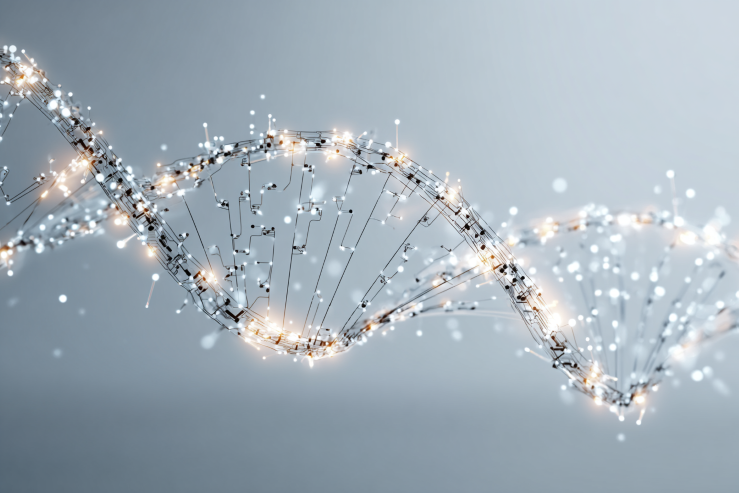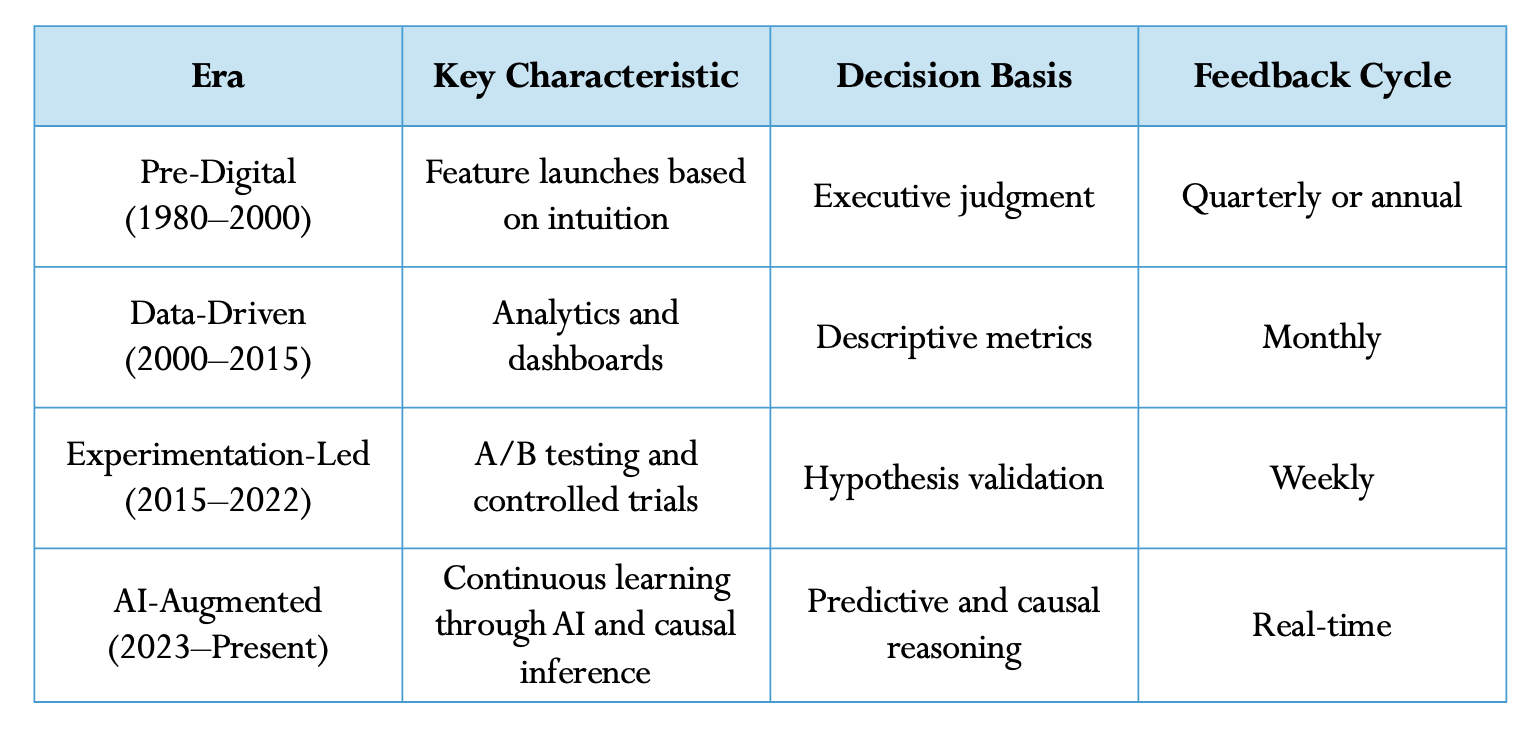
Inside the New Product DNA: AI, Causality, Experimentation
For decades, intuition, gut feel, and post-launch hindsight have driven product development. Teams brainstormed, launched features, and hoped for the best. Success stories were celebrated, and failures were dismissed as bad timing.
Today, that’s no longer the case. The new DNA of the product is intrinsically data-native and experiment-driven, where AI meets causal inference meets automation.
In this new paradigm, learning is the product itself. Every release, click, and interaction feeds a continuous feedback loop that helps products evolve faster and more intelligently.
Evolution of Product Development
Each phase has shortened the learning cycle—from slow post-mortem reviews to real-time decision-making. AI now serves as the connective tissue, turning every user signal into actionable insight.

How AI is Rewriting Product Development
AI’s impact is not just in automation, it’s in amplifying human experimentation capacity. Here’s how it’s transforming each layer of the product lifecycle:

1. Ideation → Generative Exploration
LLMs and copilots are helping teams explore what to build faster than ever. Prompt a model with “How might we reduce checkout friction for Gen Z users?” and it can instantly generate hypotheses, user flows, and even A/B test copy variants.
2. Design → Data-Infused Creativity
Design tools powered by AI (like Figma’s AI assistant or Uizard) now simulate user reactions, predict engagement heatmaps, and propose design alternatives based on prior experiment data.
3. Build → Experiment-Ready Engineering
Modern engineering frameworks integrate feature flags, metric tracking, and causal validation directly into the codebase. This allows for safe experimentation at scale, every rollout is testable by design.
4. Launch → Causal Attribution
Instead of asking “Did this feature correlate with higher conversion?” teams now ask “Did it cause it?” Causal inference frameworks (Propensity Matching, Difference-in-Differences, Meta-learners) help isolate true impact from noise.
5. Learn → Automated Knowledge Loops
Agentic AI systems summarize experiment learnings, identify patterns across experiments, and suggest next actions, forming a self-improving experimentation ecosystem.
The New Product DNA: Core Components
Modern product organizations are evolving from static roadmaps to adaptive, learning systems. At the heart of this transformation lies a new architecture (highlighted below) - a Product DNA where AI, data, and experimentation form the building blocks of continuous innovation.

Real-World Example: The AI Experimentation Loop in a Digital Health Platform
Consider a digital health platform for the management of chronic conditions such as diabetes and hypertension. The goal of this product would be to improve daily engagement through encouraging users to record their vitals, adhere to care plans, and take medication as directed. Rather than setting fixed reminders, the product team will create an AI-powered experimentation loop that continuously learns the user's behavior and gradually fine-tunes its interventions in real time.
It begins with a Data Backbone: every interaction is captured—glucose logs, step counts, coach messages, and reminders-unified into one secure telemetry system. This causal-ready foundation connects wearable sensor data, app behavior, and contextual signals like time of day and mood, allowing for cause and effect to be measured with precision.
Through the identification of such patterns, the AI Engine applies LLMs and predictive models to formulate hypotheses. It may identify that users logging meals less than 10 minutes after eating are showing a much higher degree of adherence, triggering new tests of customized notifications or even empathetic message tones for users who display fatigue.
Each of these ideas moves into the Experimentation Layer, where different behavioral nudges are compared in controlled A/B or adaptive tests. For instance, one group receives fixed daily reminders, while another group gets adaptive prompts triggered from sensor data. Effectiveness is determined by metrics such as adherence, the number of app openings, and glucose stability, each automatically favoring better variants through bandit algorithms.
The Decision Orchestrator then summarizes results-for example, "adaptive reminders improved adherence by 8% among evening users" - and schedules the next round of tests. Finally, insights feed into Feedback Memory, a long-term intelligence system that stores metadata on what worked, for whom, and why.
Over time, the platform becomes a self-learning health ecosystem where every interaction reinforces its knowledge of user behavior. The result is more than greater engagement; it's a living, data-driven product that continuously tailors care and fuels innovation.
Next in the Series
Banani’s Next Article: “Rewiring Product Management with Generative AI: From Roadmaps to Deployment.” She’ll explore how generative AI is reshaping product strategy from idea generation to roadmap alignment and real-time user feedback loops.
For decades, intuition, gut feel, and post-launch hindsight have driven product development. Teams brainstormed, launched features, and hoped for the best. Success stories were celebrated, and failures were dismissed as bad timing.
Today, that’s no longer the case. The new DNA of the product is intrinsically data-native and experiment-driven, where AI meets causal inference meets automation.
In this new paradigm, learning is the product itself. Every release, click, and interaction feeds a continuous feedback loop that helps products evolve faster and more intelligently.
Evolution of Product Development
Each phase has shortened the learning cycle—from slow post-mortem reviews to real-time decision-making. AI now serves as the connective tissue, turning every user signal into actionable insight.

How AI is Rewriting Product Development
AI’s impact is not just in automation, it’s in amplifying human experimentation capacity. Here’s how it’s transforming each layer of the product lifecycle:

1. Ideation → Generative Exploration
LLMs and copilots are helping teams explore what to build faster than ever. Prompt a model with “How might we reduce checkout friction for Gen Z users?” and it can instantly generate hypotheses, user flows, and even A/B test copy variants.
2. Design → Data-Infused Creativity
Design tools powered by AI (like Figma’s AI assistant or Uizard) now simulate user reactions, predict engagement heatmaps, and propose design alternatives based on prior experiment data.
3. Build → Experiment-Ready Engineering
Modern engineering frameworks integrate feature flags, metric tracking, and causal validation directly into the codebase. This allows for safe experimentation at scale, every rollout is testable by design.
4. Launch → Causal Attribution
Instead of asking “Did this feature correlate with higher conversion?” teams now ask “Did it cause it?” Causal inference frameworks (Propensity Matching, Difference-in-Differences, Meta-learners) help isolate true impact from noise.
5. Learn → Automated Knowledge Loops
Agentic AI systems summarize experiment learnings, identify patterns across experiments, and suggest next actions, forming a self-improving experimentation ecosystem.
The New Product DNA: Core Components
Modern product organizations are evolving from static roadmaps to adaptive, learning systems. At the heart of this transformation lies a new architecture (highlighted below) - a Product DNA where AI, data, and experimentation form the building blocks of continuous innovation.

Real-World Example: The AI Experimentation Loop in a Digital Health Platform
Consider a digital health platform for the management of chronic conditions such as diabetes and hypertension. The goal of this product would be to improve daily engagement through encouraging users to record their vitals, adhere to care plans, and take medication as directed. Rather than setting fixed reminders, the product team will create an AI-powered experimentation loop that continuously learns the user's behavior and gradually fine-tunes its interventions in real time.
It begins with a Data Backbone: every interaction is captured—glucose logs, step counts, coach messages, and reminders-unified into one secure telemetry system. This causal-ready foundation connects wearable sensor data, app behavior, and contextual signals like time of day and mood, allowing for cause and effect to be measured with precision.
Through the identification of such patterns, the AI Engine applies LLMs and predictive models to formulate hypotheses. It may identify that users logging meals less than 10 minutes after eating are showing a much higher degree of adherence, triggering new tests of customized notifications or even empathetic message tones for users who display fatigue.
Each of these ideas moves into the Experimentation Layer, where different behavioral nudges are compared in controlled A/B or adaptive tests. For instance, one group receives fixed daily reminders, while another group gets adaptive prompts triggered from sensor data. Effectiveness is determined by metrics such as adherence, the number of app openings, and glucose stability, each automatically favoring better variants through bandit algorithms.
The Decision Orchestrator then summarizes results-for example, "adaptive reminders improved adherence by 8% among evening users" - and schedules the next round of tests. Finally, insights feed into Feedback Memory, a long-term intelligence system that stores metadata on what worked, for whom, and why.
Over time, the platform becomes a self-learning health ecosystem where every interaction reinforces its knowledge of user behavior. The result is more than greater engagement; it's a living, data-driven product that continuously tailors care and fuels innovation.
Next in the Series
Banani’s Next Article: “Rewiring Product Management with Generative AI: From Roadmaps to Deployment.” She’ll explore how generative AI is reshaping product strategy from idea generation to roadmap alignment and real-time user feedback loops.








